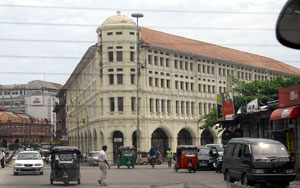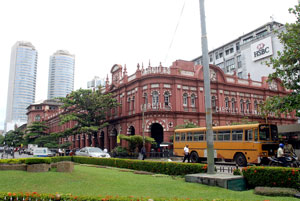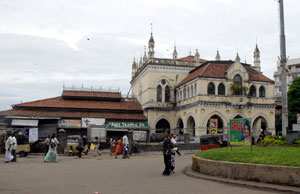A city is not static. It evolves like a living organism. This evolution may take its shape from many determinants. Among these, nature--where it is built, man who came to that nature, and society formed by him, are uppermost.
The story of Colombo is somewhat different. This commercial capital was elevated to the status of a city by colonialists. Later, the city was converted into an administrative capital by the British.
Colombo, being the commercial capital, demands any intervention to be aimed at regeneration of its city life. Its capacity to attract investors, accommodate a diversified living society, facilitate meeting and exchange, and symbolize Sri Lanka as the commercial capital, is heavily dependent on its evolved character, which should be given due consideration in planning development. In other words, it is essential to protect the image of Colombo, its character and identity and the continuity of a living society in assigning new functions and accommodating new users.
Our failure to address the issue of cultural and heritage values of Colombo will result in a lost space as such attempts will destroy the city’s capacity to hold a living society. Colombo, we note, is one of the most fitting examples to test the hypothesis of development through conservation- using cultural and heritage values to design a development framework. Our challenge would thus be identifying the composition of diverse urban quarters with distinctive character and then understanding the cultural values of those urban quarters. By emphasising the links between those quarters, we may note the scale and type of new development weaving into the conservation-worthy built fabric.
Conservation and Development are usually considered as two contrasting actions: the first ensuring continuity of the existing, while the latter brings change. Conservation or development, if focused on physical aspects, will not strengthen city life. They both have evidently become non-sustainable though they have a common goal to improve the quality of life. Conservation that is development-oriented and development that respects the ecological balance of the place could facilitate a continuous dialogue between society and its space thus reinforcing the liveability of urban space.
Conservation policies are now moving away from petrifying a historicity towards strengthening the cultural significance of a place, thus identifying the potential of integrating development within the carrying capacity of a place as such making conservation a social and cultural phenomenon. This integration of conservation and development supports the evolving consciousness of the concept of heritage as a resource available to anchor, assist, assess and guide the city’s evolution. Development through Conservation, embarking with a focused documentation, proposes a positive alternative to sustainable development.
Conservation has conservatively been defined as petrifying monumental buildings and/or their remains. This has even gone to the extent of recreating pasts in its original form to restore an artefact for future generations. This ideology was transported to the urban context, turning the historic city into a frozen space where city life cannot continue. Many conserved historic cities have faced degradation of city life as a result. Some cities experience an emerging new life as they have become tourist destinations or settings of a more affluent society as conservation has given it a new meaning.
Our proposal is not to import life patterns that have little to do with living society, its day-to-day activities or its particular origin and evolution, but to regenerate the old city fabric to make conservation of Colombo an economic feasibility. In addition to new uses and users, it is necessary to take measures to control rents, land ownership, and land utilization to control undue increase of property values or gentrification but without curtailing the growth of the city. Infusion of so-called cultural activities to make the historic fabric function alone may not be sustainable in Colombo but striking a balance between conservation of historic fabric and adding new may make the city function as one unit.
It is possible to identify the following strengths of urban conservation: first, it maintains recognizable reference points in the city so that we would not be disorientated, rootless, and alienated, second, it enriches our lives and the city by not discarding anything of distinctive beauty, and third it brings a range of economic benefits through tourism and other similar windfall gains. These strengths in improving quality of life mean a regenerated urban space.
Colombo’s urban sectors, streets, buildings, uses, and intangible contents could be proclaimed for heritage values and for their role in composing the image, which makes it this particular city. This image, also represents how a society perceives the city in identifying and orienting within the urban space. These components outlive the society and as such may demand new interpretations or changes to house new functions, uses, and users. Our challenge would be accommodating them without compromising the composed image of the city and without curtailing its evolution.
It is rather necessary to understand the alarming issue of housing the under-served community, who occupy reservations and some areas that could be made attractive for new developments. It is a known fact that this community is needed to service and run the city but their occupying the heart of the city creates problems to the development of the Colombo. We find accommodating them within the city limits through a proper development plan feasible, thus enhancing the city character and improving living conditions.
Development through conservation has potential to diversify the city for grasping the city as an urban system and allowing the protection of the city’s gestalt rather than its individual elements.
The strength of this attitude would be using the spaces in between those elements to reinforce the gestalt while accommodating the uses and users essential for the city. The value system that understands the cultural significance of that particular gestalt plays a vital role in regenerating Colombo rather than preserving its age, artistic, architectural components. As proclaiming the historic city necessarily means placing it within the present-day value system, this attitude acknowledges life that has evolved in the city, thus placing emphasis with its own production system, social structures, and sub-societies, strengthening the liveability of the urban space. This integration of new living patterns in the old setting is what Colombo needs for regeneration of its social economic life.
In Colombo, there are many urban quarters demanding a diverse degree of integration of protection and replacement. The most striking is the Fort, where we see the colonial legacy- the origin of the city and its interpretation in the post-colonial eras. In addition to the historic built fabric dominated by the Governor’s House, street layout dominated by Main Street shows a potential historic quarter that could be conserved for compatible functions such as commercial, trading and socio-cultural activities. By infusing such activities in controlled types and scales, we could bring the life back to the city centre, which is today haunted in the nights and on holidays.
It is a fact that Fort and its immediate surroundings are occupied by many defence-related activities such as headquarters of armed forces, ministries, etc thus creating an issue of security in regenerating night life in the fort. Since Colombo Fort is a valuable resource, it is high time that the authorities seriously consider leaving this occupied land for more activities that would instigate social and economic development.
Among major buildings that are under-used or unused are the Dutch hospital, General Post Office building, Grindlays Bank, Gaffoor building, and among the most potential urban resources- the streetscapes of Chatham Street and York Street. In our opinion, these have the most potential urban elements to regenerate the city life in Colombo. All these buildings would demand a retrofitting but their location and strength show that they are ready to play the role.
As an academic exercise, we have identified such uses and the possible changes to historic structures. Our approach has been based on an urban typo-morphological analysis thus prescribing possible uses and users for those buildings, which would protect the overall image of Colombo and prevent its compartmentalization. Being in close proximity to the port, which should have been used more for leisure activities than commercial shipping, Fort has much potential in accommodating more high-end tourist activities. We propose inserting of cultural and social activities along with the commercial activities to instigate a balance between locals and visitors. For example, the Dutch Hospital that is not properly maintained today could become the City Museum- assigning a function in order to save this abandoned treasure, and Gaffoor building, a city hotel, etc. Since Fort is the financial hub of Colombo, encouraging banks and other financial institutions to make a return will solve the problem of maintaining the historic built fabric.
The street layout of Pettah, the Dutch Orphanage on Prince Street, old churches, and the most untapped resource of Colombo- the waterways and the Beira Lake should be drawn into the planning of regeneration of city life. Since Colombo was planned as a fortified city, most of the structures do not use waterfronts effectively. As one can expect, the waterways are polluted and unused in terms of leisure and pleasure. It is high time we understand this mistake thus encouraging a new urban typology to harness the beauty of the city.
At the same time, the balance between the residential quarters of Colombo should be maintained. The most discussed planning proposal of the Panchikawatta triangle should be given priority while drawing attention to the housing of the under-served community. However, not only the under-served community should live in the city. A piecemeal attempt of city beautiful or real estate exchange through mere housing, which resembles a filing-cabinet architecture, should be replaced with an integrated attempt to regenerate city life. The involvement of professionals and academics in supporting such an integrated attempt should also be investigated. Our exercises have concluded the low-cost and low-energy housing typologies to satisfy such demands without threatening the development of the city.
True development of a country is always reflected in the emphasis on human, social and cultural development. This is clear from the works of the King Dutugemunu who built colossal stupas to today’s rulers who plan for the development of cultural activities.
The Mahinda Chinthana emphasizes the need to protect cultural heritage in its chapter called Uruma-aruma. Our intention is to emphasize the essential balance between conservation and development and the socio-economic bias of any conservation in the scenario of implementing this idea. Authenticity of culture can be carried on down the ages, forming true sustainable development. This continuity striking a balance between evolving consciousness and an eroding past by ascribing values could uplift the living conditions while promoting social cohesion and human dignity. Colombo is the best window to show the rest of the world that we have truly become the miracle of Asia.
The writer is Head,
Department of Architecture,
University of Moratuwa |




